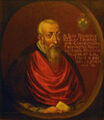Template:Selected anniversaries/November 21: Difference between revisions
Jump to navigation
Jump to search
No edit summary |
No edit summary |
||
| Line 11: | Line 11: | ||
||1877 – Thomas Edison announces his invention of the phonograph, a machine that can record and play sound. | ||1877 – Thomas Edison announces his invention of the phonograph, a machine that can record and play sound. | ||
File:Clock Head 2.jpg|link=Clock Head 2|1904: Mechanical engineer [[Clock Head 2]] warns theoretical physicist [[Albert Einstein (nonfiction)|Albert Einstein]] that the mass–energy equivalence formula, E = mc², will have "earth-shaking consequences." | |||
File:Albert Einstein 1921.jpg|link=Albert Einstein (nonfiction)|1905: [[Albert Einstein (nonfiction)|Albert Einstein]]'s paper that leads to the mass–energy equivalence formula, E = mc², is published in the journal ''Annalen der Physik''. | File:Albert Einstein 1921.jpg|link=Albert Einstein (nonfiction)|1905: [[Albert Einstein (nonfiction)|Albert Einstein]]'s paper that leads to the mass–energy equivalence formula, E = mc², is published in the journal ''Annalen der Physik''. | ||
Revision as of 14:02, 16 November 2017
1652: Mathematician, physician, and astronomer Jan Brożek dies. He contributed to a greater knowledge of Nicolaus Copernicus' theories and was his ardent supporter and early prospective biographer.
1676: Astronomer Ole Rømer presents the first quantitative measurements of the speed of light.
1904: Mechanical engineer Clock Head 2 warns theoretical physicist Albert Einstein that the mass–energy equivalence formula, E = mc², will have "earth-shaking consequences."
1905: Albert Einstein's paper that leads to the mass–energy equivalence formula, E = mc², is published in the journal Annalen der Physik.



